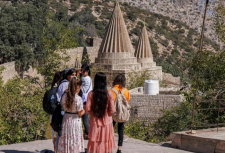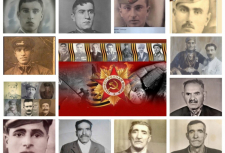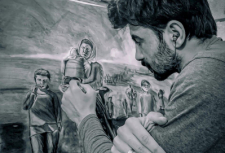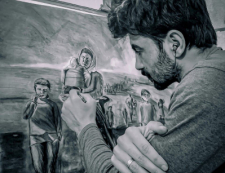The forgotten people: yazidi history of the last genocide
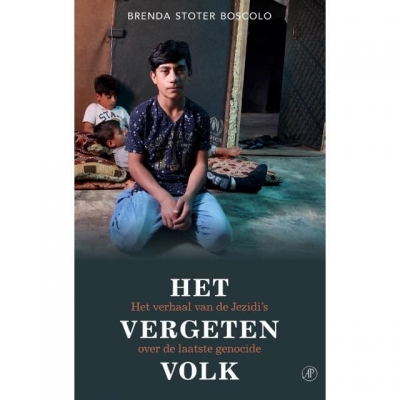
Autor - Minka Nijhuis
In the summer of 2014, is invaded the Sinjar region in Northern Iraq. Hundreds of thousands of residents fled to Iraqi Kurdistan or mount Sinjar. Without food or water, many died of starvation. But ISIS came not only to expand the Caliphate, but also to root out the Yazidis, a community with their own religion and ancient culture. Men were killed, women and girls were sold into slavery, and boys were sent to ISIS training camps. Five years after the start of the genocide, little has changed for the Yazidis: due to political tensions, Sinjar is now an abandoned area, is members are not being prosecuted for genocide, and thousands of Yazidis are still missing. What is the future of a nation that has struggled for centuries to survive?
Journalist Brenda Stoter Boscolo went to Iraq to write about the Yazidis. She soon discovered that genocide is much more than sexual slavery, which is the focus of the media. In the refugee camps, she studied the latest genocide, their history and culture, and formed close friendships. She followed the fates of Ismail, who had thirty-five relatives kidnapped, Majdal, who was made a child soldier by ISIS, Salim, who lost his entire family, and Nadima, who became the mother of a child by an ISIS fighter.
Brenda Stoter Boscolo introduces the reader to the world of genocide victims.
In the summer of 2014, journalist Brenda Stoter Boscolo learned via Twitter and online resources that tens of thousands of civilians had fled in Northern Iraq as a result of another terrorist attack. Desperate and without any protection, they were trapped. When Stoter Boscolo took a closer look at one of the photos, she recognized the headdress that women used to shield their faces from the scorching heat.
In an area populated by Kurds and Arabs, throughout history, the Yazidis have maintained an identity with characteristic customs and rituals, and a life that takes place in a closed community. The woman told the journalist how her people were persecuted for centuries. The woman was afraid that new violence against Yazidis by ISIS was hanging over her head.
Yazidi men were killed and thrown into mass graves during the ISIS violence. Women and children were taken as slaves: women and girls were turned into sex slaves and subjected to violence, abuse and forced marriages. Boys were brainwashed in training camps and used as fighters.
The beheadings, tortures, and rapes of ISIL fighters were widely discussed in the international media. Brenda noted that the victims themselves and their desire for recognition and justice for what was done to them received much less journalistic attention. When one of them asked her: "Why don't you write a book about us?"- the decision was made quickly. What seems almost a tourist excursion during her first encounter with this minority in 2013 turns into a thorough journalistic research trip. Over the years, Stoter has interviewed dozens of women, children, and men who have experienced the brutality of terrorists. For example, she chose not to include in her book a detailed conversation with Nadia Murad, who became the face and voice of persecuted Yazidis around the world after she publicly testified before the UN Security Council about how she was made a sex slave.
"Every mother loves her child," Nadima says, even if she gave birth to a child as a result of rape. But unfortunately, the woman did not see her child, little Adam, again after her husband broke his promise that the child would also be welcome when Nadima returned to the community. Children conceived by ISIL are not welcome in the community, although some religious leaders are in favor of accepting them. Stoter Boscolo wrote down all these little Chronicles.
It does not consider the interviewees victims, but shows their terrible experiences and injuries, as well as their ability to survive. Stoter Boscolo turned to various sources, such as government representatives, religious leaders, scientists, doctors, and students.
The young journalist made friends during her research, but despite her personal involvement, she remained critical. The book also reads as a guide to the ethics of the journalistic profession. The word "sex slaves", often used in other media, avoids them. She shows respect and empathy. The well-being of the Yazidis she interviews about their tragic experiences puts them above her ambitions as a journalist to make the most of it. By including her personal insights and experiences in the book, she also invites her readers to share their work as a freelance journalist. She does this almost casually, without depriving the reader of the opportunity to see the fate of the Yazidis.
"Tell the world our story," she was told repeatedly. She did it with skill and integrity. It made the document as unique as it was interesting.
groene.nl
Tags: #yazidisinfo #newsyezidi #aboutyazidi #genocideyezidi #MinkaNijhuis #ezidi2014 #BrendaStoterBoscolo
The forgotten people: yazidi history of the last genocide

Autor - Minka Nijhuis
In the summer of 2014, is invaded the Sinjar region in Northern Iraq. Hundreds of thousands of residents fled to Iraqi Kurdistan or mount Sinjar. Without food or water, many died of starvation. But ISIS came not only to expand the Caliphate, but also to root out the Yazidis, a community with their own religion and ancient culture. Men were killed, women and girls were sold into slavery, and boys were sent to ISIS training camps. Five years after the start of the genocide, little has changed for the Yazidis: due to political tensions, Sinjar is now an abandoned area, is members are not being prosecuted for genocide, and thousands of Yazidis are still missing. What is the future of a nation that has struggled for centuries to survive?
Journalist Brenda Stoter Boscolo went to Iraq to write about the Yazidis. She soon discovered that genocide is much more than sexual slavery, which is the focus of the media. In the refugee camps, she studied the latest genocide, their history and culture, and formed close friendships. She followed the fates of Ismail, who had thirty-five relatives kidnapped, Majdal, who was made a child soldier by ISIS, Salim, who lost his entire family, and Nadima, who became the mother of a child by an ISIS fighter.
Brenda Stoter Boscolo introduces the reader to the world of genocide victims.
In the summer of 2014, journalist Brenda Stoter Boscolo learned via Twitter and online resources that tens of thousands of civilians had fled in Northern Iraq as a result of another terrorist attack. Desperate and without any protection, they were trapped. When Stoter Boscolo took a closer look at one of the photos, she recognized the headdress that women used to shield their faces from the scorching heat.
In an area populated by Kurds and Arabs, throughout history, the Yazidis have maintained an identity with characteristic customs and rituals, and a life that takes place in a closed community. The woman told the journalist how her people were persecuted for centuries. The woman was afraid that new violence against Yazidis by ISIS was hanging over her head.
Yazidi men were killed and thrown into mass graves during the ISIS violence. Women and children were taken as slaves: women and girls were turned into sex slaves and subjected to violence, abuse and forced marriages. Boys were brainwashed in training camps and used as fighters.
The beheadings, tortures, and rapes of ISIL fighters were widely discussed in the international media. Brenda noted that the victims themselves and their desire for recognition and justice for what was done to them received much less journalistic attention. When one of them asked her: "Why don't you write a book about us?"- the decision was made quickly. What seems almost a tourist excursion during her first encounter with this minority in 2013 turns into a thorough journalistic research trip. Over the years, Stoter has interviewed dozens of women, children, and men who have experienced the brutality of terrorists. For example, she chose not to include in her book a detailed conversation with Nadia Murad, who became the face and voice of persecuted Yazidis around the world after she publicly testified before the UN Security Council about how she was made a sex slave.
"Every mother loves her child," Nadima says, even if she gave birth to a child as a result of rape. But unfortunately, the woman did not see her child, little Adam, again after her husband broke his promise that the child would also be welcome when Nadima returned to the community. Children conceived by ISIL are not welcome in the community, although some religious leaders are in favor of accepting them. Stoter Boscolo wrote down all these little Chronicles.
It does not consider the interviewees victims, but shows their terrible experiences and injuries, as well as their ability to survive. Stoter Boscolo turned to various sources, such as government representatives, religious leaders, scientists, doctors, and students.
The young journalist made friends during her research, but despite her personal involvement, she remained critical. The book also reads as a guide to the ethics of the journalistic profession. The word "sex slaves", often used in other media, avoids them. She shows respect and empathy. The well-being of the Yazidis she interviews about their tragic experiences puts them above her ambitions as a journalist to make the most of it. By including her personal insights and experiences in the book, she also invites her readers to share their work as a freelance journalist. She does this almost casually, without depriving the reader of the opportunity to see the fate of the Yazidis.
"Tell the world our story," she was told repeatedly. She did it with skill and integrity. It made the document as unique as it was interesting.
groene.nl
Tags: #yazidisinfo #newsyezidi #aboutyazidi #genocideyezidi #MinkaNijhuis #ezidi2014 #BrendaStoterBoscolo













